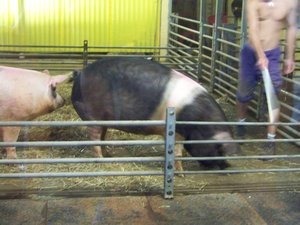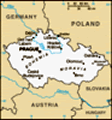Advertisement

 Prague 008
Prague 008
One of the Czech Spotted pigsI am currently distraught. This has nothing to do with Prague, school, or really anything that should logically have any bearing on my life. But one of my favorite Penguins defensemen just signed with LA. I might have cried a little bit. Also, it really sucks to be on another continent when major things are happening in the NHL because I get this information at about two in the morning.
Yesterday we went to a farm in Zihle, which I’m pretty sure is west of Prague but I could be wrong. On our way there we drove through a town named Kladno. I was wondering why it sounded so familiar and ran it through my head a few times, trying to figure out why I knew it (and assuming it was hockey-related somehow). Then one of the Czechs (I can’t remember if it was Vlasta or Lošt’ak) told us that it was Jaromir Jagr’s hometown. I honestly don’t know what to think about the fact that I remembered that, other than I clearly spend too much time reading about this sport. To get back on topic, the farm at Zihle was huge with three different units. I can’t remember

 Prague 029
Prague 029
Dairy barnthe exact acreage but I do know it was bordering on a crazy amount of land. We met with the farm manager and talked to him for about 45 minutes. Ha talked a bit about the state of agriculture in Europe and the Czech Republic, which is apparently not too great. Since the Czech Republic is so small it’s hard for them to compete on a global market. They also have a lot of regulations on animal welfare and other environmental factors from the European Union that the US doesn’t have to worry about. After our “meeting” we went out to different parts of the farm.
First we headed to the pig unit. The farm raises two types of pig, an older Czech Spotted breed, and a white breed that wasn’t quite named (but it’s the same breed everyone thinks of…name escapes me right now. Hampshire?). On the outside, the farm looked a lot like ours in the States. We went into one of the barns used as an auction barn, and the workers brought out some of the pigs for us to see. On average, they seemed to be a good bit fatter than most commercially raised hogs

 Prague 030
Prague 030
Czech Red Spotted cowI’ve seen in the US. We were told that’s a particularly unfortunate trait of the Czech breed: they’re very fertile but have a high percentage of body fat, which is bad in a product because consumers don’t want fatty meat. One sow was brought out with her litter and we were told that the piglets are kept with their mothers for about 21-25 days (I forget the exact number). I found that interesting because I’m pretty sure piglets are taken straight away back home. I wish we could have seen the barns that the pigs were housed in, just to see how they compare to farms in the US.
We also went to the dairy unit of the farm at Zihle, where they keep Holstein and Czech Red Spotted cattle. I thought the barn was very interesting. The cattle were kept chained at stations in rows in the barn with automatic waterers shared between two cows. The dairy manager told us that they were kept there all the time. One of the kids from OSU lives on a dairy farm and told us that stanchion barns are very outdated, and even when they were used more commonly in the

 Prague 033
Prague 033
Memorial to the children of LidiceStates the cows were only kept tied during the day and turned out at night. I thought it was odd that the EU would be so concerned about animal welfare but be ok with this type of dairy management. Something else that I nearly forgot about: the barn had music playing when we walked in, and we were informed that the farm was part of a study to see if playing different types of music would have any impact on milk production (or, I would assume, the behavior of the cows). You mean to tell me they’re looking into things like what type of music the cows like, but they keep them chained in a poorly ventilated (and hot) barn day and night? Interesting.
On our way home from Zihle we stopped at Lidice. Lidice was a town a little way outside of Prague that was completely and systematically destroyed by the Nazis during WWII. There was a museum that documented what happened with video and pictures. It reminded me a lot of the Holocaust Museum in DC. The Nazis separated the village by gender, taking all the men over the age of 15 and shooting them. Then the children were taken to concentration camps, with those having blue eyes and blonde hair being adopted out to German families for “Germanization.” Somewhere around 82 of the children were gassed, and there was a memorial to them on the grounds of the museum. There was a very moving video of some of the survivors telling their stories about being taken and losing their families. I was left wondering how someone could so methodically destroy an entire village with such planned movements as the Nazis did. How is there not a point where you think about what you’re doing and realize that it’s completely wrong?
Advertisement
Tot: 0.09s; Tpl: 0.011s; cc: 5; qc: 45; dbt: 0.0393s; 1; m:domysql w:travelblog (10.17.0.13); sld: 1;
; mem: 1.1mb








GranStu
non-member comment
Hi Sweetheart, Boy, you are busy, busy, busy. Love the letters and the pictures but miss your pretty face. Looking forward to seeing _ALL_ your pictures when you come home. As for all that running from place to place, remember the words of Yogi Berra, "You've got to be very careful if you don't know where you are going because you might not get there." Love you, Grandma